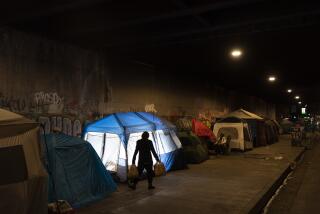To the Bottom and Back : Executive Loses Job to Crack, Recovers and Reclaims It
- Share via
Forty-eight floors is a long way to fall.
It’s an even longer climb back up if you’re a successful business executive who one day is working in a Los Angeles high-rise--and the next is living with crack cocaine addicts in a filthy alley at the edge of downtown.
Ezell Williams took the tumble nearly five years ago. It has taken him until now to climb out. But he’s back.
He has his old job again--he’s an executive recruiter for a Wilshire Boulevard employment service. But he says he has a new attitude. One that he hopes will keep him off drugs and off the streets from now on.
Williams, 51, was one of the stars at Carson Thomas Personnel until 1992, when his drug habit collided with his work ethic.
Lunchtime in those days would find him in an alley near the corner of Olympic Boulevard and Georgia Street, hustling rocks of cocaine to smoke. He would sometimes return to his office hours late and barely able to function.
The expense of cocaine cost him his Eagle Rock home and forced him into a cheap hotel. He began trading his business suits for drugs.
Still, “I was cocky about being able to handle my situation,” he remembers.
But of course he couldn’t.
“One day I’d been up five or six days without sleep. Our office was on the 48th floor and at that height helicopters flew below us,” Williams said. “I was sitting at my desk when I looked out when one went by. I said, ‘I think I just saw one of the apostles fly past the window.’ ”
After that, he went to company owners Sandra Carson and Frank Thomas and quit his job.
“I don’t think I ever told them I was smoking cocaine. But it was obvious to them I was doing drugs. I told them it was more than drugs--it was a lifestyle.”
Carson, of Whittier, was shocked. But not surprised.
“He had been coming in late, leaving early. Things were happening to his clothes--his appearance was starting to change,” she said. “You could see the decline . . . it was an awful thing to see.”
But a funny thing happened: Carson told Williams his job would be waiting for him if he wanted to return.
“He’d done a marvelous job for us. The clients liked him, so did his co-workers,” she said. “I hoped the potential was still there.”
Without a job, Williams was soon out of his hotel and on the street. He moved into a homeless encampment in an alley near 8th and Alvarado streets, sleeping beneath a crudely fashioned tent.
“I’d never even ever camped out before,” he said. “It wasn’t comfortable.”
He pushed a shopping cart around the streets, collecting bottles and cans to recycle for cash. Sometimes he sold drugs. He perfected his panhandling technique--”street drama” is the way Williams puts it--for money to buy food.
“I’d do it in front of the Pantry and then go in to eat. I’d see people I recognized. But most didn’t recognize me. I wasn’t wearing a suit, and that alone changes a person.”
Williams at first was surprised that to some he had become an invisible man. But in time, life on the the street became more comfortable.
There were aspects of his new life that Williams enjoyed. Drugs were close at hand. And he could get high whenever he wanted to.
“I didn’t have to answer to anyone or be anywhere at any time,” said Williams--who first used drugs in 1966, when he got out of the Air Force and began smoking marijuana. He started using cocaine in 1973 after a divorce.
Soon, Williams built a second tent--using a roomy parachute that was lighted from the outside by a nearby overhead lamp. It was tall enough to stand up in and outfitted with a bed and milk-crate bookcases.
Someone gave Williams a battery-operated TV so he could watch the 1994 basketball playoffs. After the championship game, he sold it for drug money.
Thomas, his old employer, tracked Williams down and tried without success to get him off the street. So did Williams’ daughter, Dawn O’Brien, 27, of Laguna Beach, after Thomas helped her find Williams at his encampment.
Williams hit bottom on Oct. 5, 1995, while visiting a Beverly Boulevard welfare office to apply for general relief.
A case worker called Williams’ mother in Alabama to verify information on the application form. Before hanging up, he handed the phone to Williams.
Williams was horrified when his mother told him his brother had died months earlier and she had been unable to reach him with the news.
“I was crying when I walked out of there,” he said. “I saw how irresponsible I’d become.”
Distraught, Williams walked aimlessly for hours. When he stopped, he was outside the Los Angeles Mission on 5th Street. He went in and signed up for a drug rehabilitation program on the spot.
Williams spent a year in the mission’s “Fresh Start,” a counseling program that aims to build discipline and job skills for the homeless while they live at the shelter.
About two-thirds of the 75 or so who graduate annually manage to remain drug-free a year later, according to mission statistics. Slightly more than half find employment after finishing the program. Few return to their old jobs, however.
“I wish I could tell you Ezell’s typical. But he’s more of a rarity,” said the Rev. James Lewis, the mission vice president in charge of rehabilitation programs. “Most people when they end up down here have destroyed past relationships.”
Carson and Thomas made good on their offer to take Williams back when they learned he was in the mission program. During its final four months, he worked one day a week at their office familiarizing himself with things like new computer programs.
Wearing suits borrowed from the mission, Williams has worked full-time for the past two months. To Carson’s surprise--and relief--”he stepped back in almost at the same pace he was before,” she said.
*
These days, Williams occasionally stops by the alley where he lived. The homeless there treat him with respect, he said. They put away their crack pipes when they see him coming.
He’s persuaded several of his old friends to go to the mission, but none has yet signed up for the rehabilitation program, Williams said.
“There are a lot of people who need to know it can be done,” he said of his own return to the business world. “People need to know nothing is hopeless.
“Not everybody out there on the streets is mentally ill, or a criminal. One friend of mine on the street had been the author of children’s books. One was a 15-year Rockwell aeronautical engineer. A couple were attorneys.”
Seeing them still out there hurts, Williams said. But in a way it helps, too.
“It’s a strong deterrent from that lifestyle to me now,” he said.
“I need a dose of that every once in a while--a reality check.”



